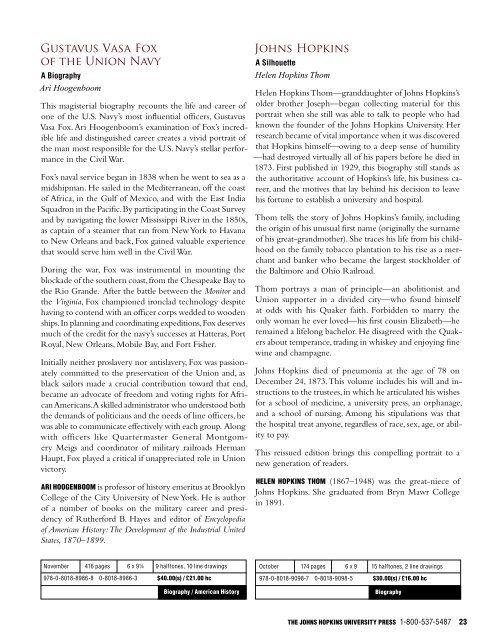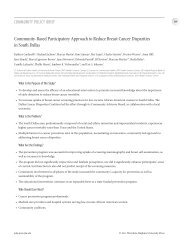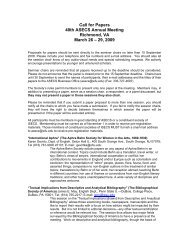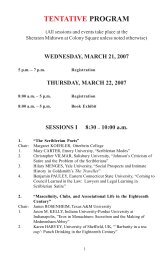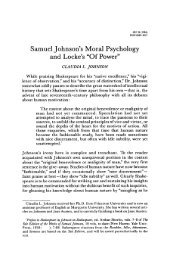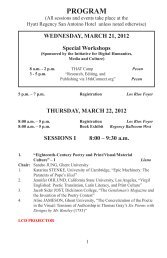Fall 2008 - The Johns Hopkins University Press
Fall 2008 - The Johns Hopkins University Press
Fall 2008 - The Johns Hopkins University Press
You also want an ePaper? Increase the reach of your titles
YUMPU automatically turns print PDFs into web optimized ePapers that Google loves.
Gustavus Vasa Foxof the Union NavyA BiographyAri HoogenboomThis magisterial biography recounts the life and career ofone of the U.S. Navy’s most influential officers, GustavusVasa Fox. Ari Hoogenboom’s examination of Fox’s incrediblelife and distinguished career creates a vivid portrait ofthe man most responsible for the U.S. Navy’s stellar performancein the Civil War.Fox’s naval service began in 1838 when he went to sea as amidshipman. He sailed in the Mediterranean, off the coastof Africa, in the Gulf of Mexico, and with the East IndiaSquadron in the Pacific. By participating in the Coast Surveyand by navigating the lower Mississippi River in the 1850s,as captain of a steamer that ran from New York to Havanato New Orleans and back, Fox gained valuable experiencethat would serve him well in the Civil War.During the war, Fox was instrumental in mounting theblockade of the southern coast, from the Chesapeake Bay tothe Rio Grande. After the battle between the Monitor andthe Virginia, Fox championed ironclad technology despitehaving to contend with an officer corps wedded to woodenships. In planning and coordinating expeditions, Fox deservesmuch of the credit for the navy’s successes at Hatteras, PortRoyal, New Orleans, Mobile Bay, and Fort Fisher.Initially neither proslavery nor antislavery, Fox was passionatelycommitted to the preservation of the Union and, asblack sailors made a crucial contribution toward that end,became an advocate of freedom and voting rights for AfricanAmericans. A skilled administrator who understood boththe demands of politicians and the needs of line officers, hewas able to communicate effectively with each group. Alongwith officers like Quartermaster General MontgomeryMeigs and coordinator of military railroads HermanHaupt, Fox played a critical if unappreciated role in Unionvictory.Ari Hoogenboom is professor of history emeritus at BrooklynCollege of the City <strong>University</strong> of New York. He is authorof a number of books on the military career and presidencyof Rutherford B. Hayes and editor of Encyclopediaof American History: <strong>The</strong> Development of the Industrial UnitedStates, 1870–1899.<strong>Johns</strong> <strong>Hopkins</strong>A SilhouetteHelen <strong>Hopkins</strong> ThomHelen <strong>Hopkins</strong> Thom—granddaughter of <strong>Johns</strong> <strong>Hopkins</strong>’solder brother Joseph—began collecting material for thisportrait when she still was able to talk to people who hadknown the founder of the <strong>Johns</strong> <strong>Hopkins</strong> <strong>University</strong>. Herresearch became of vital importance when it was discoveredthat <strong>Hopkins</strong> himself—owing to a deep sense of humility—had destroyed virtually all of his papers before he died in1873. First published in 1929, this biography still stands asthe authoritative account of <strong>Hopkins</strong>’s life, his business career,and the motives that lay behind his decision to leavehis fortune to establish a university and hospital.Thom tells the story of <strong>Johns</strong> <strong>Hopkins</strong>’s family, includingthe origin of his unusual first name (originally the surnameof his great-grandmother). She traces his life from his childhoodon the family tobacco plantation to his rise as a merchantand banker who became the largest stockholder ofthe Baltimore and Ohio Railroad.Thom portrays a man of principle—an abolitionist andUnion supporter in a divided city—who found himselfat odds with his Quaker faith. Forbidden to marry theonly woman he ever loved—his first cousin Elizabeth—heremained a lifelong bachelor. He disagreed with the Quakersabout temperance, trading in whiskey and enjoying finewine and champagne.<strong>Johns</strong> <strong>Hopkins</strong> died of pneumonia at the age of 78 onDecember 24, 1873. This volume includes his will and instructionsto the trustees, in which he articulated his wishesfor a school of medicine, a university press, an orphanage,and a school of nursing. Among his stipulations was thatthe hospital treat anyone, regardless of race, sex, age, or abilityto pay.This reissued edition brings this compelling portrait to anew generation of readers.Helen <strong>Hopkins</strong> THOm (1867–1948) was the great-niece of<strong>Johns</strong> <strong>Hopkins</strong>. She graduated from Bryn Mawr Collegein 1891.November 416 pages 6 x 9¼ 9 halftones, 10 line drawings978-0-8018-8986-8 0-8018-8986-3 $40.00(s) / £21.00 hcBiography / American HistoryOctober 174 pages 6 x 9 15 halftones, 2 line drawings978-0-8018-9098-7 0-8018-9098-5 $30.00(s) / £16.00 hcBiographyTHE JOHNS HOPKINS UNIVERSITY PRESS 1-800-537-5487 23


